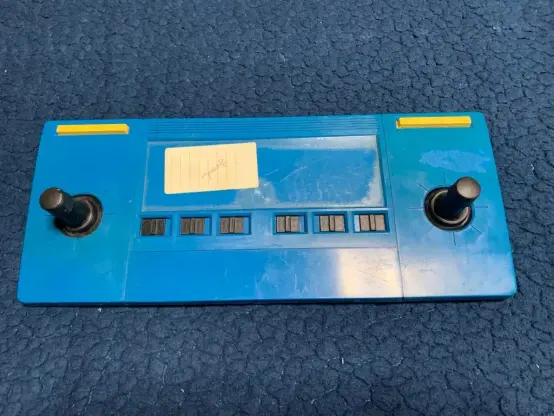Another prototype of Atari CX-2000 console (nicknamed Val) has been found https://forums.atariage.com/topic/386503-previously-undocumented-atari-cx-2000-val-prototype-found-in-the-wild/ #Atari2600 #Atari
#atari2600
Dear Santa...
« Kiki », 1986
320x200 pixels, 16 colours
By Speedy Graphito (French street artist, b. 1961)
Illustration for a 1986 French advert for the Atari 1040 STf
#atari #atariart #ataripixelart #demoscene #atari2600 #atari8bit #atariST #atariLynx #atariJaguar #atariFalcon #SpeedyGraphito #320x200pixels #16colours
Views from Planet Irata #16
« Kwame Nkrumah Mausoleum », Accra, Ghana, 1992
By Don Arthur, architect
#atari #atariart #ataripixelart #demoscene #atari2600 #atari8bit #atariST #atariArchitecture #viewsFromPlanetIrata
Views from Planet Irata #15
« Sompo Japan Nipponkoa Head Office Building », Tokyo, Japan, 1973
By Yoshikazu Uchida, architect
#atari #atariart #ataripixelart #demoscene #atari2600 #atari8bit #atariST #atariArchitecture #viewsFromPlanetIrata
Views from Planet Irata #14
« Borj-e Azadi », Teheran, Iran, 1971
By Hossein Amanat, architect
#atari #atariart #ataripixelart #demoscene #atari2600 #atari8bit #atariST #atariArchitecture #viewsFromPlanetIrata
Views from Planet Irata #13
« Neprihănita Zămislire », Orșova, România, 1972-1976
By Hans Fackelmann, architect
#atari #atariart #ataripixelart #demoscene #atari2600 #atari8bit #atariST #atariArchitecture #viewsFromPlanetIrata
Views from Planet Irata #12
« Hipodrom microraionul », housing complex, Brāila, Romania, 1971
By Stefan Cocioaba, architect
#atari #atariart #ataripixelart #demoscene #atari2600 #atari8bit #atariST #atariArchitecture #viewsFromPlanetIrata
Views from Planet Irata #11
« Engineering Fountain », Purdue University, West Lafayette, USA, 1989
By Robert Yougman, architect
#atari #atariart #ataripixelart #demoscene #atari2600 #atari8bit #atariST #atariArchitecture #viewsFromPlanetIrata
Views from Planet Irata #10
« Côte des Basques hotel complex », Biarritz Atlantic Coast, France, 1969
Unreleased project
#atari #atariart #ataripixelart #demoscene #atari2600 #atari8bit #atariST #atariArchitecture #viewsFromPlanetIrata
Views from Planet Irata #08
« Robert Rathbun Wilson Hall at Fermi National Accelerator Laboratory (Fermilab) » Batavia, Illinois, 1970
by Alan H. Rider, architect
#atari #atariart #ataripixelart #demoscene #atari2600 #atari8bit #atariST #atariArchitecture #viewsFromPlanetIrata
Views from Planet Irata #07
« Rudo Buildings », Belgrade, Serbia, 1976
by Vera Cirkovic, architect
#atari #atariart #ataripixelart #demoscene #atari2600 #atari8bit #atariST #atariArchitecture #viewsFromPlanetIrata
Views from Planet Irata #06
« Plaza y Foro de la Democratia », Atizapán de Zaragoza, Mexico, 2009
by José Luis Arbesù Verduzco, architect
#atari #atariart #ataripixelart #demoscene #atari2600 #atari8bit #atariST #atariArchitecture #viewsFromPlanetIrata
Views from Planet Irata #05
« Atari Hotel San Francisco », Atari Interactive, GSD Group
planned 2022 - CANCELLED
#atari #atariart #ataripixelart #demoscene #atari2600 #atari8bit #atariST #atariArchitecture #viewsFromPlanetIrata
Views from Planet Irata #04
« Atari Hotel Las Vegas», Atari Interactive, GSD Group, planned 2022 - CANCELLED
#atari #atariart #ataripixelart #demoscene #atari2600 #atari8bit #atariST #atariArchitecture #viewsFromPlanetIrata
Views from Planet Irata #03
« Atari Headquarters », Sunnyvale. California, c. 1976
#atari #atariart #ataripixelart #demoscene #atari2600 #atari8bit #atariST #atariArchitecture #viewsFromPlanetIrata
Views from Planet Irata #02
« AtariForce Northcal Headquarters », 1982
Design by Neal Pozner (American comics artist, 1955-1994)
In #AtariForce #1, DC Comics, 1982
#atari #atariart #ataripixelart #demoscene #atari2600 #atari8bit #atariST #NealPozner #atariArchitecture #viewsFromPlanetIrata
Views from Planet Irata #01
« Atari City », 1983
poster by Tim White (British artist, 1952-2020)
#atari #atariart #ataripixelart #demoscene #atari2600 #atari8bit #atariST #atariLynx #atariJaguar #atariFalcon #TimWhite #atariArchitecture #viewsFromPlanetIrata
Atari spirit, Atari traditional art, Atari ads and visuals, Atari games, Atari pixel artists and Atari demoscene art...
Enjoy and, of course... stay Atari...
#atari #atariart #ataripixelart #demoscene #atari2600 #atari8bit #atariST #atariLynx #atariJaguar #atariFalcon
TinyELF Basic, new #BASIC interpreter for #Atari2600 console equipped with UnoCart/PlusCart+/Chameleon cartridges and KeyPortari keyboard adapter https://youtu.be/XVjKs3T-lYo #atari





















